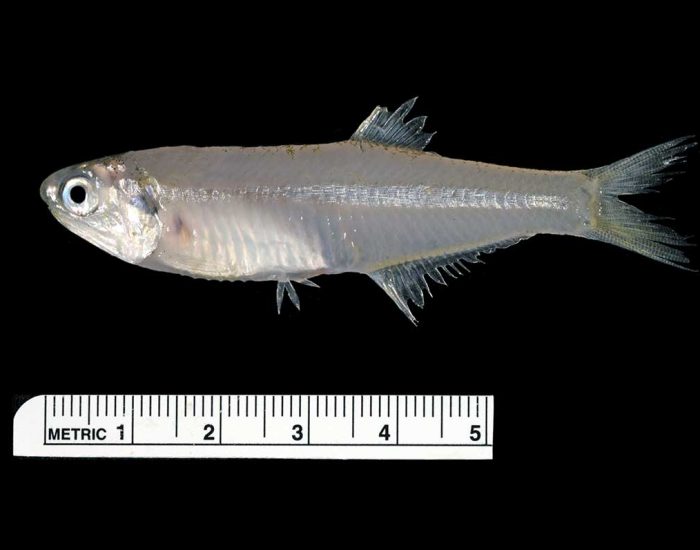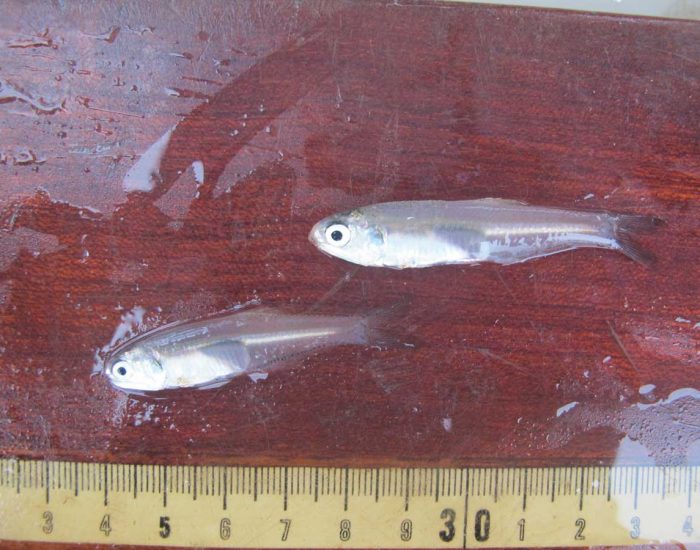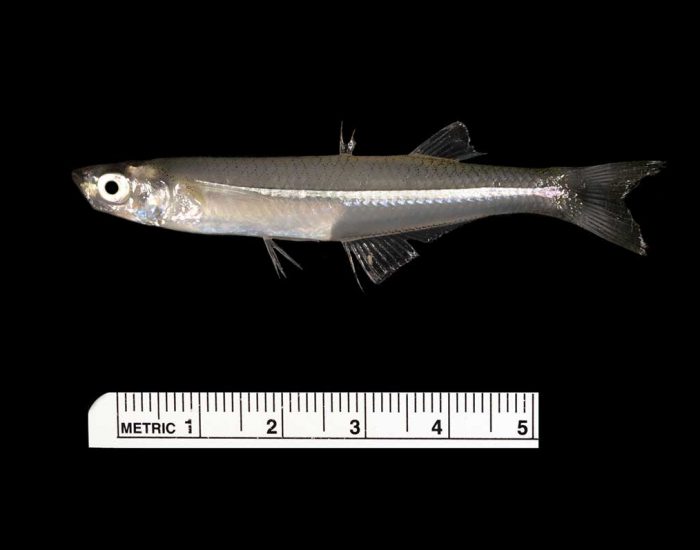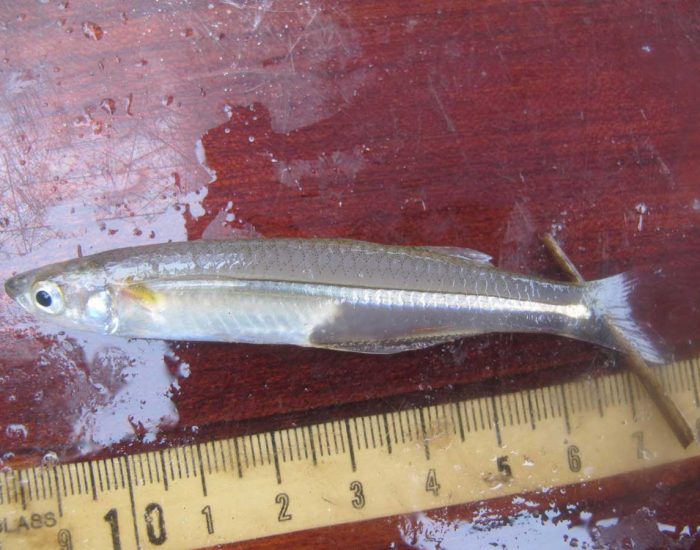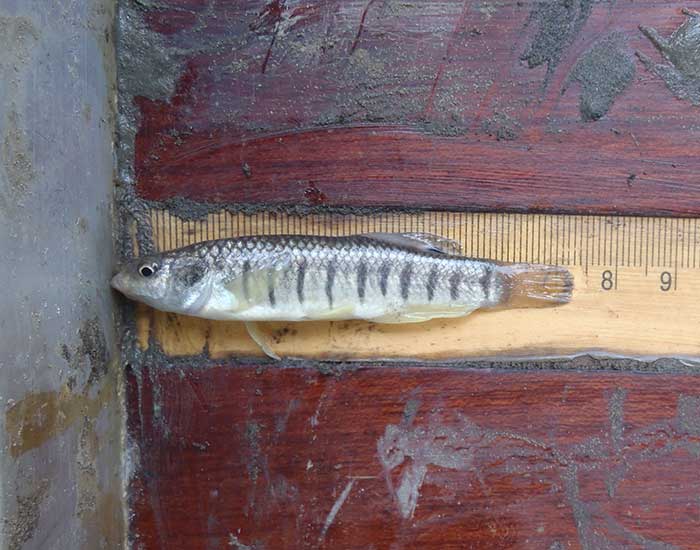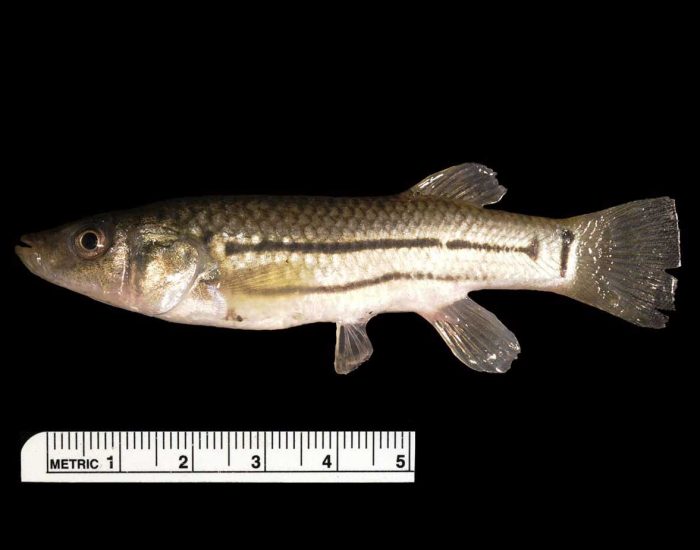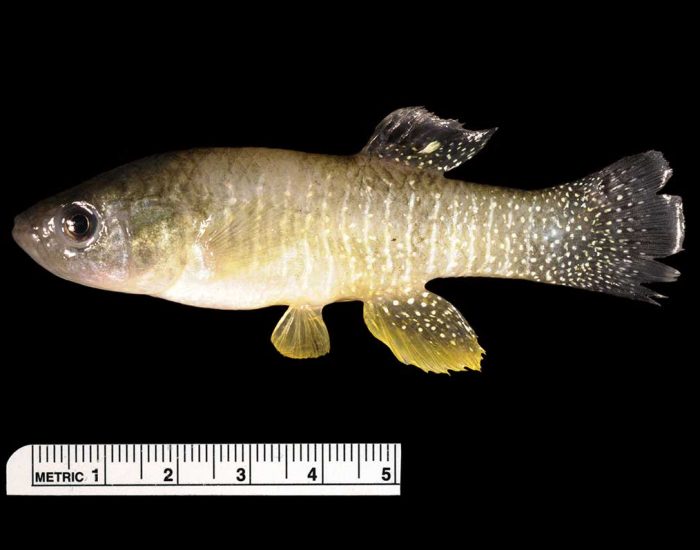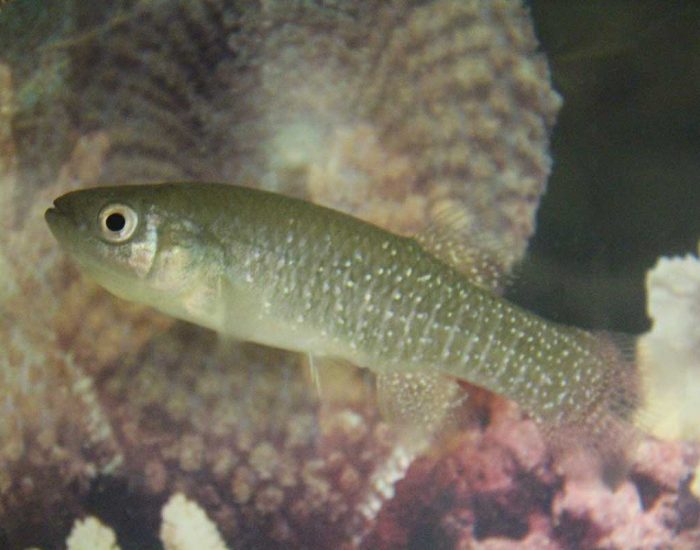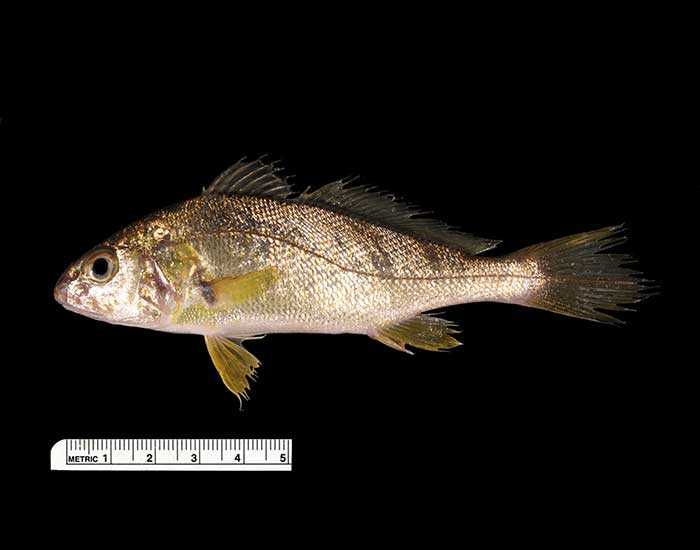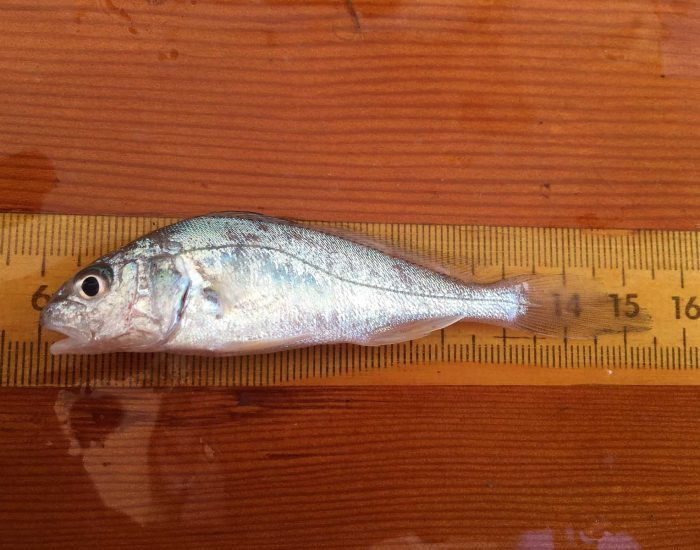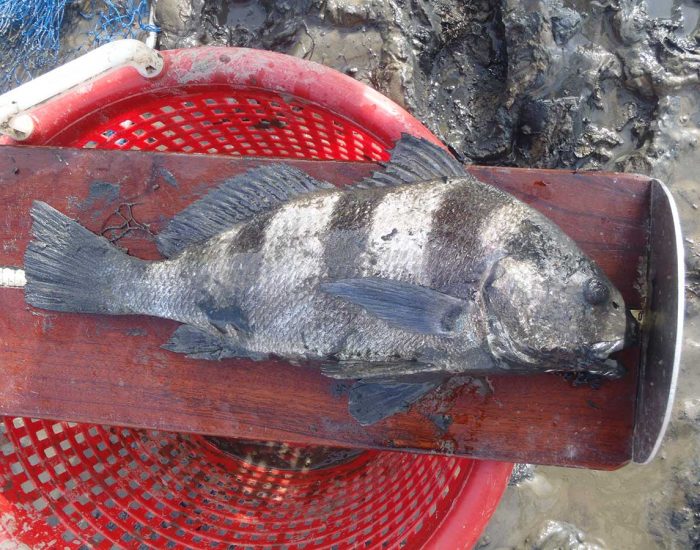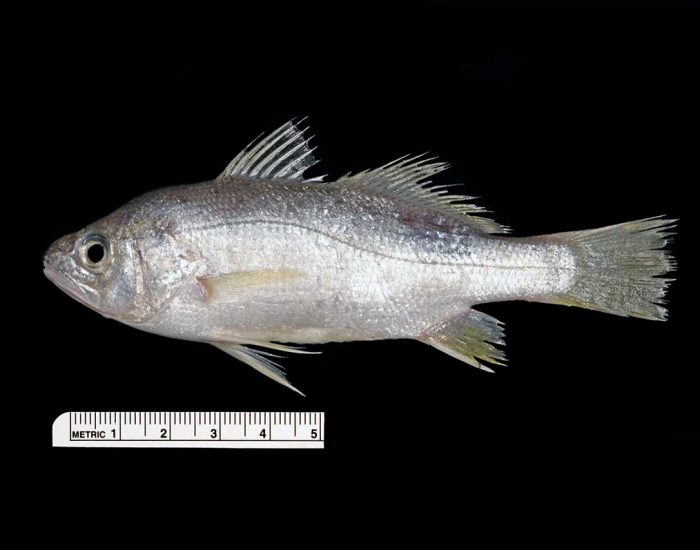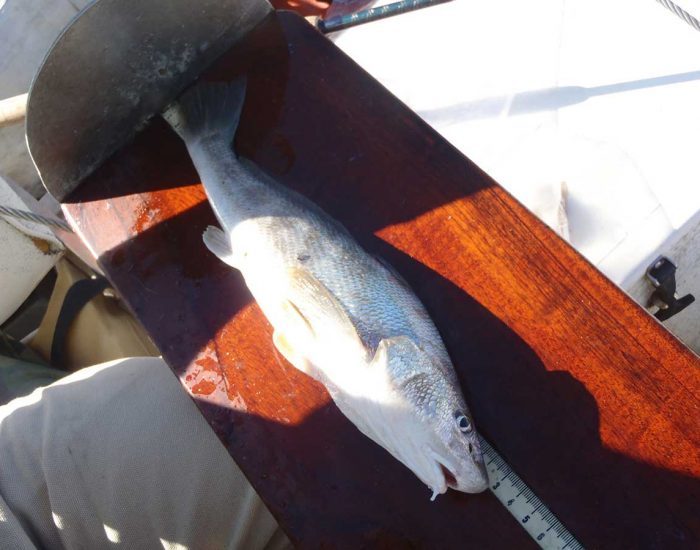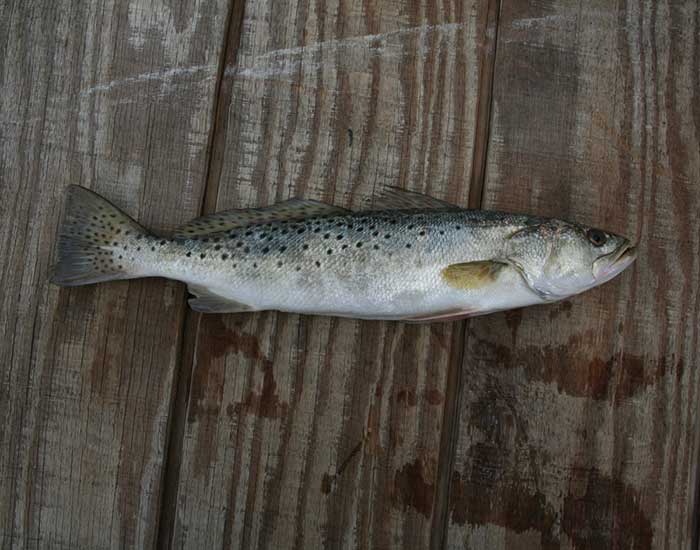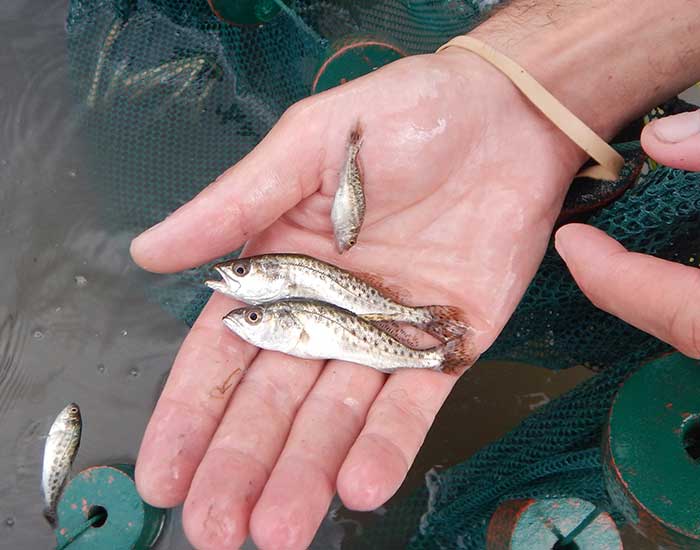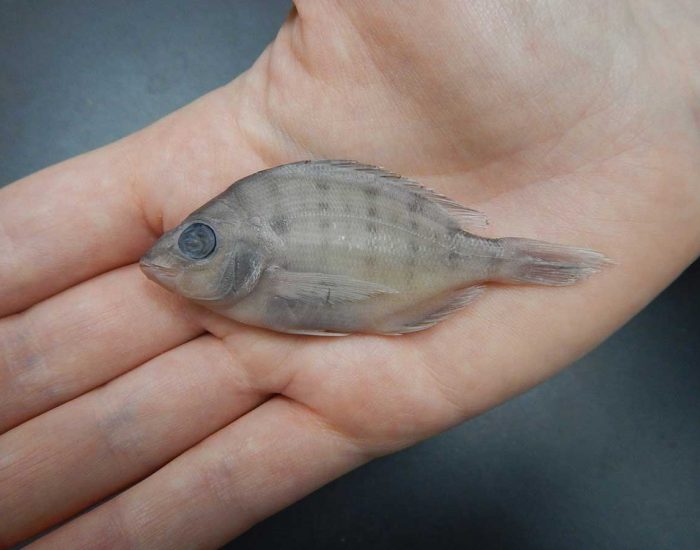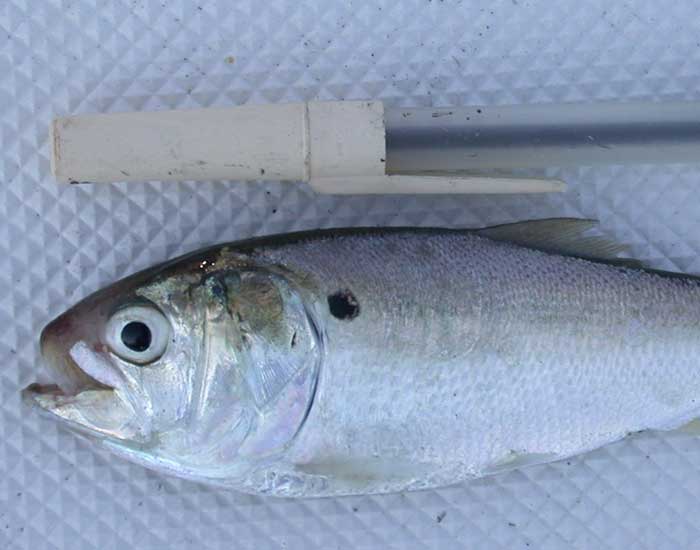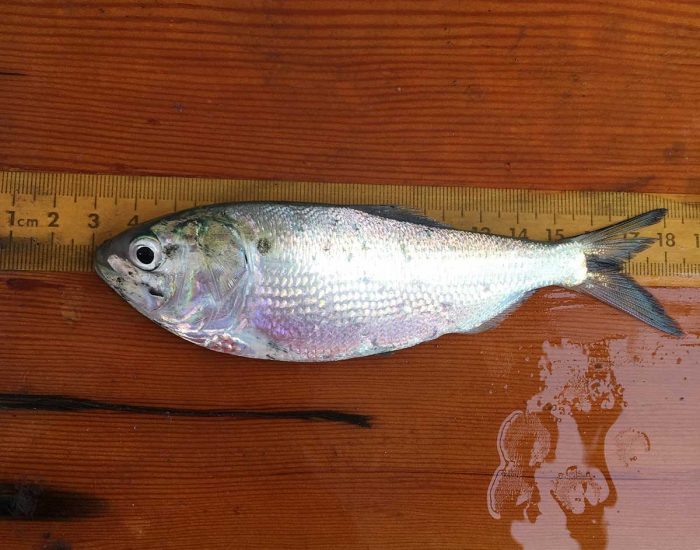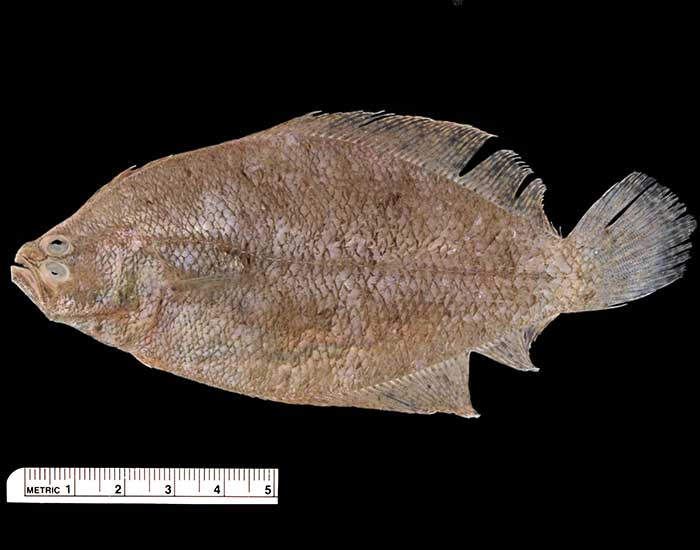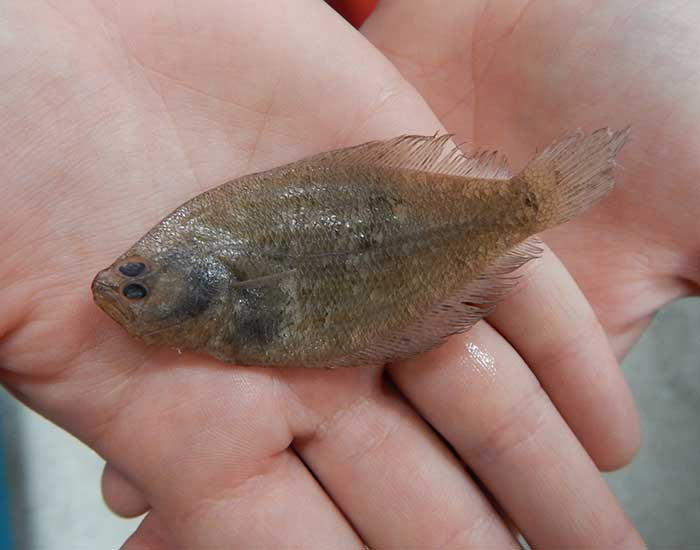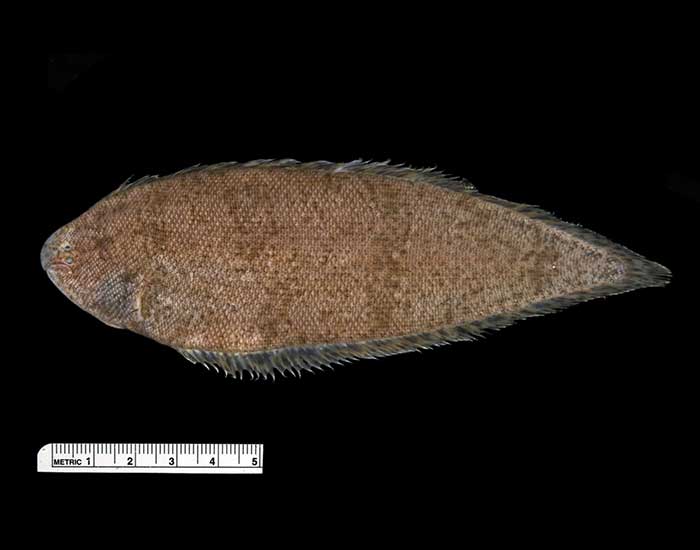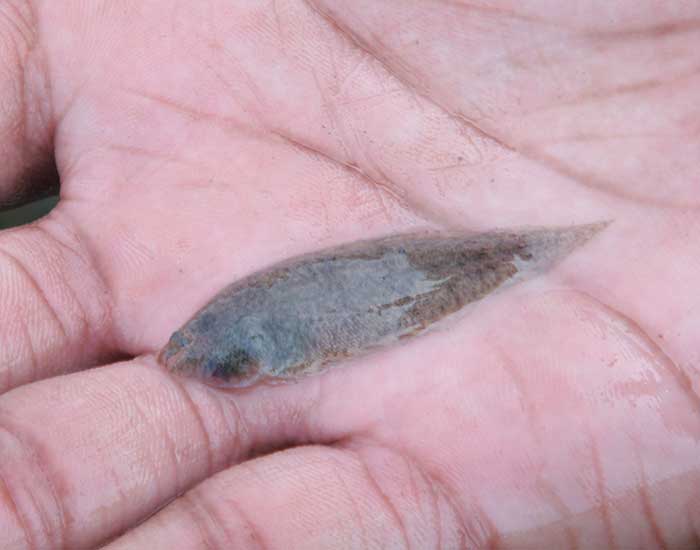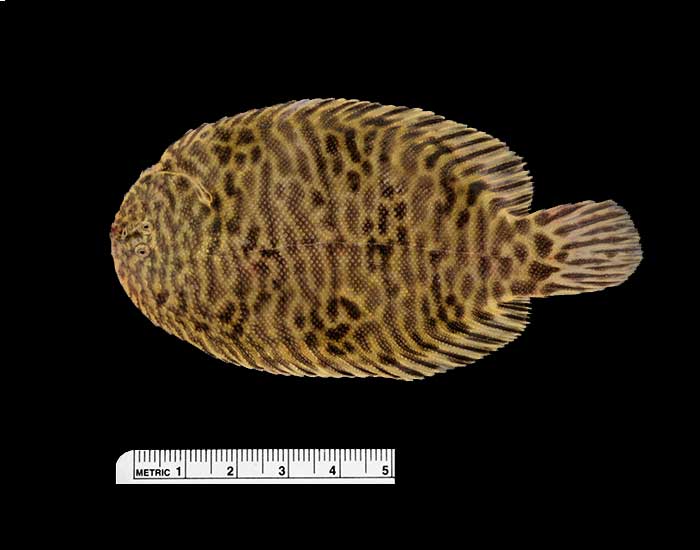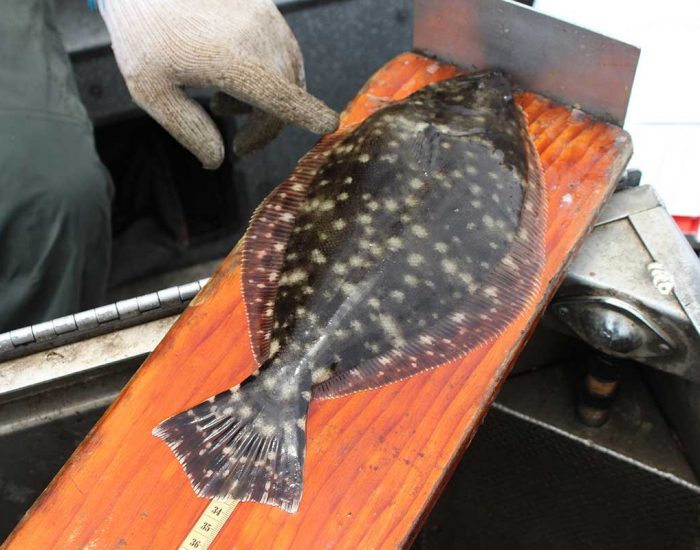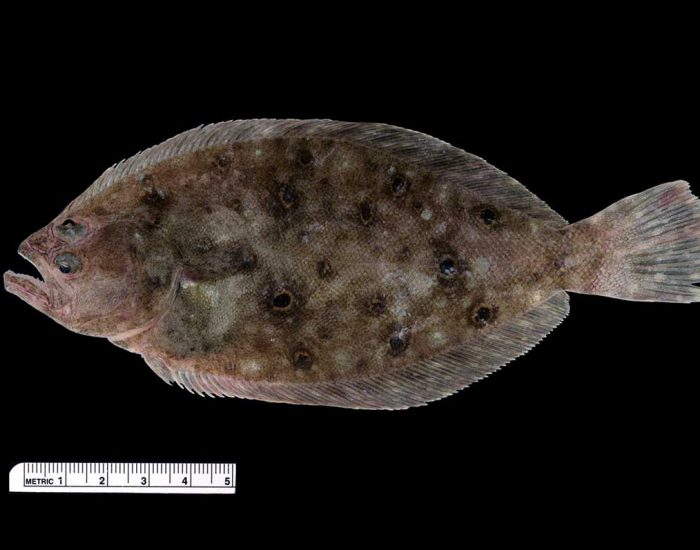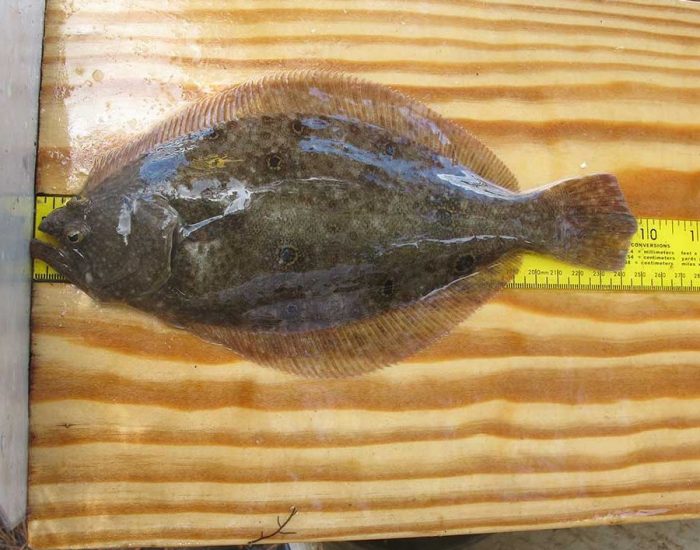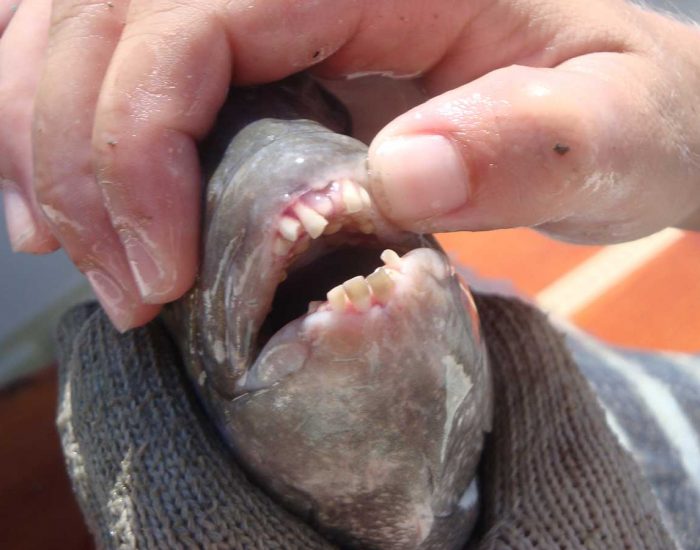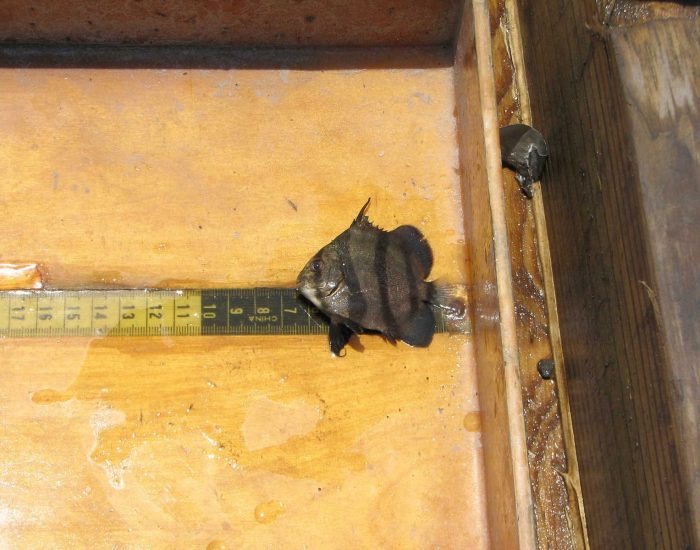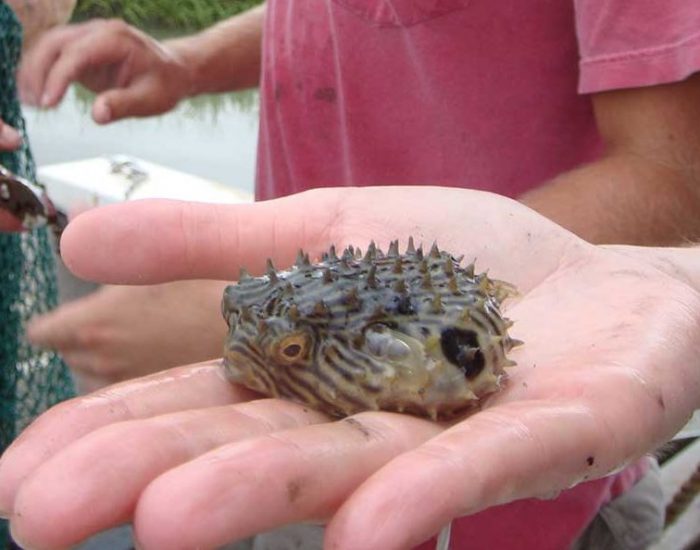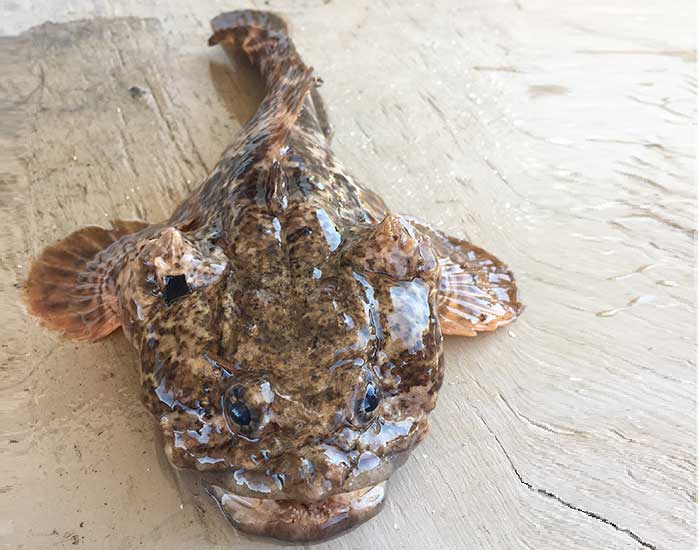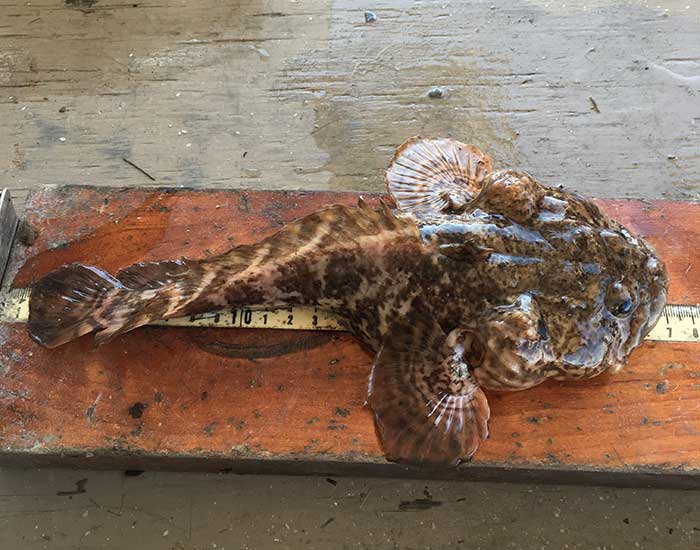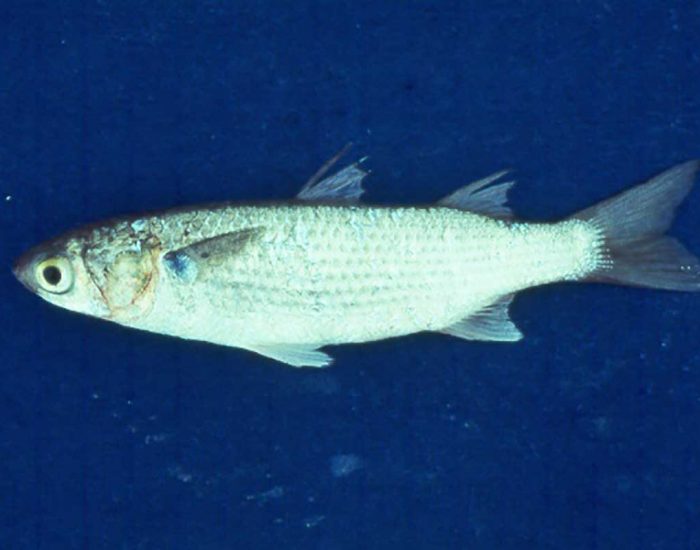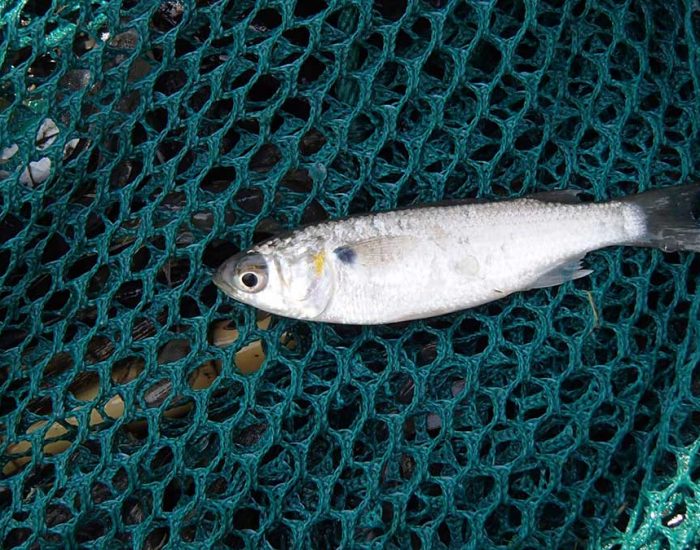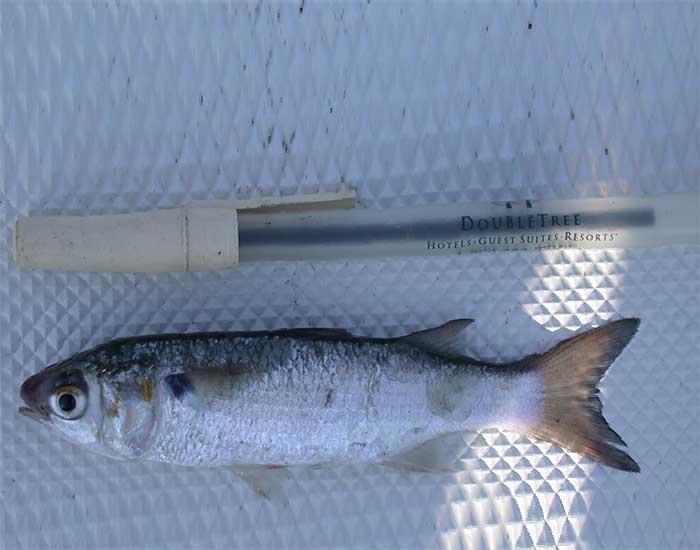Bony Fishes
Class Osteichthyes
This class is comprised of the bony fish (osteo = “bone”), and has the most species in it of all the vertebrate classes. Bony fishes have rays of gills on both sides of their head, which are covered by an operculum (“little door”) for protection. This class of fish also has an air sac, or swim bladder, that allows them to control their buoyancy, meaning they can float in one spot without sinking.
Bony fishes come in a variety of shapes and sizes, but most follow a standard body plan regarding fin type and placement. Some fish, like the flounder, may look completely different from a typical fish, but will still have the same fin types. While our diagram below shows you a standard fish body plan, what we would like to highlight particularly is the function of each of the fins.
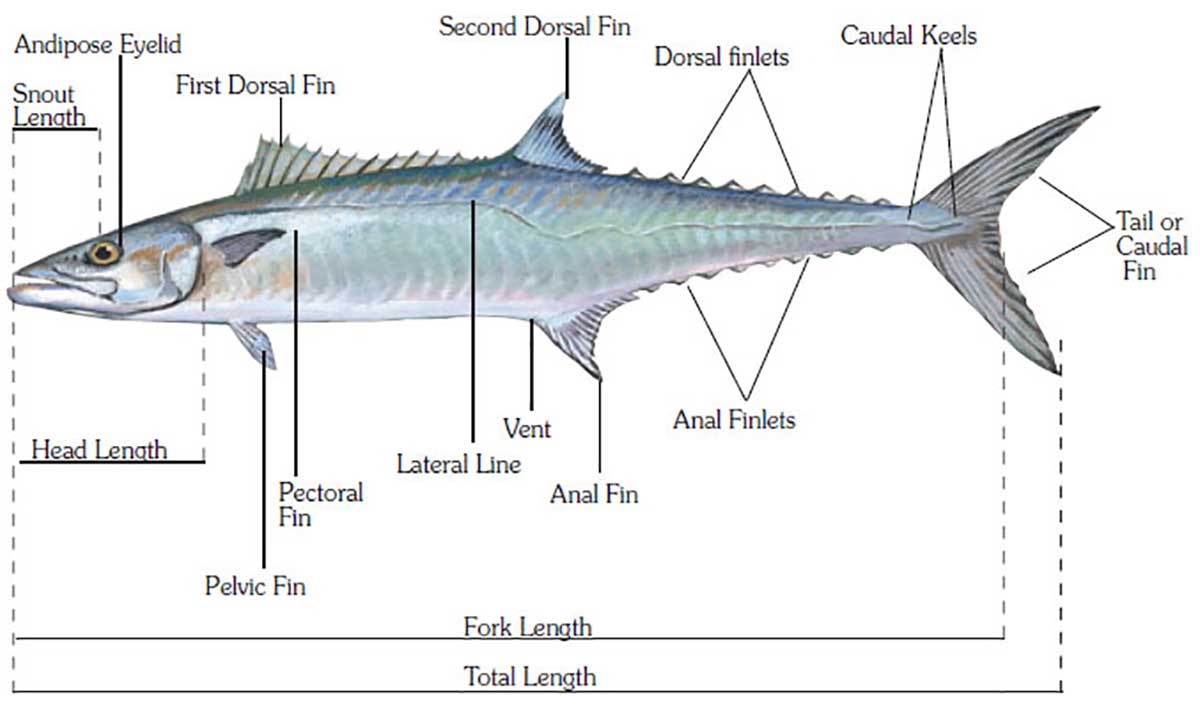
Dorsal fin: aids in balance, keeping the fish upright
Caudal fin: used for propulsion, to move the fish
Pectoral fin: used for steering and maneuvering around objects
Pelvic fin: helps fish go up and down, helps fish turn quickly
Anal fin: works with the dorsal fin to aid in balance and stability
Bay anchovy O
Anchoa mitchilli
- Characteristics:
- Small fish with faint silver stripe down sides; out of the water, will usually be lacking scales; dorsal fin originates over the origin of the anal fin
- Range:
- Atlantic coast of the U.S. and the Gulf of Mexico
- Size:
- Up to 4in (10cm) in length
- Habitat:
- Coastal ocean to the upper reaches of tidal creeks
- Fun Fact:
- Main source of nutrition for the endangered least tern

Atlantic silverside O
Menidia menidia
- Characteristics:
- Looks similar to anchovy except smaller mouth; conspicuous silver stripe down side of body; pointed snout
- Range:
- Atlantic coast of the U.S.
- Size:
- Up to 5in (13cm) in length
- Habitat:
- Sandy shorelines, estuaries and tidal creeks
- Fun Fact:
- Sensitive to environmental changes, such as depleted oxygen; absence can be used as an indicator of poor water quality

Striped killifish C
Fundulus majalis
- Characteristics:
Silver sheen on sides; females with long stripes and a couple of bars near the tail; males have 15-20 bars
- Range:
Atlantic coast of the U.S.
- Size:
Up to 6-7in (17cm) in length
- Habitat:
Tidal creeks and beach shallows
- Fun Fact:
Not as common as mummichog but also play a large role in estuary food webs, prey for most birds and fish in marsh

Mummichog O
Fundulus heteroclitus
- Characteristics:
- Small brown-green fish with pale spots along the body; males are brighter with bars along the side
- Range:
- Gulf of St. Lawrence to Gulf Coast of Texas
- Size:
- Up to 6in (15cm) in length
- Habitat:
- Resident in tidal creeks, sometimes in freshwater
- Fun Fact:
- “mummichog” comes from an Indian word meaning “going in crowds,” referring to its common schooling behavior

Atlantic croaker C
Micropogonias undulatus
- Characteristics:
Silver with faint dark bars on sides; faint black spot above pectoral fin
- Range:
Atlantic coast of the U.S. and the Gulf of Mexico
- Size:
Up to 20in (51cm) in length
- Habitat:
Estuaries, tidal creeks to several miles offshore
- Fun Fact:
Make a loud croaking sound by vibrating the swim bladder

Black drum C
Pogonias cromis
- Characteristics:
Deep-bodied, silver to dark gray with black tinted fins; lower jaw with barbels extending down; large scales
- Range:
Atlantic coast of the U.S. and the Gulf of Mexico
- Size:
Averages 14in (36cm) in length
- Habitat:
Live bottom in estuaries, rare in tidal creeks, beaches; often near hard structures such as jetties and docks
- Fun Fact:
Use their barbels to sense for food along the bottom

Red drum C
Sciaenops ocellatus
- Characteristics:
Bronze or red colored with one or more dark spots near tail fin
- Range:
Atlantic coast of the U.S. and the Gulf of Mexico
- Size:
Up to 4-5ft (1.5m) in length
- Habitat:
Nearshore, estuaries, tidal creeks
- Fun Fact:
Spot on the caudal fin is used to distract predators; most caught estuarine drum are sexually immature

Silver perch C
Bairdiella chrysoura
- Characteristics:
- Silver body with yellow fins, anal fin has prominent spine; dorsal fin has a deep notch
- Range:
- NY to FL, the Gulf of Mexico
- Size:
- Up to 9in (23cm) in length
- Habitat:
- Shallow estuarine waters, primarily tidal creeks
- Fun Fact:
- will often make loud drumming sounds with their swim bladder when caught

Southern kingfish C
Menticirrhus americanus
- Characteristics:
Long, silver body with 7-8 bars on sides; fins yellow; small mouth with a single short barbel on chin
- Range:
Cape Cod to northern Argentina
- Size:
Averages 6-10in (15-25cm) in length
- Habitat:
Estuaries, along beaches and near mouths of rivers
- Fun Fact:
Most abundant of three kingfish species in SC; not frequently seen in tidal creeks

Spot C
Leiostomus xanthurus
- Characteristics:
Silver-blue dorsal and silver-yellow ventral; 12-15 bars along sides; spot behind operculum, above pectoral fin
- Range:
Atlantic coast of the U.S. and the Gulf of Mexico
- Size:
Up to 10in (25cm) in length
- Habitat:
Shallow muddy bottoms of estuaries, tidal creeks, often around oyster reefs
- Fun Fact:
Larvae develop offshore then move into the estuaries

Spotted seatrout C
Cynoscion nebulosus
- Characteristics:
Dark gray dorsally with black spots along the body; two large teeth on the tip of the upper jaw
- Range:
NY to the Gulf of Mexico
- Size:
Up to 30in (76cm) in length
- Habitat:
Inshore live bottom habitats in estuaries and tidal creeks
- Fun Fact:
Delicate fish, care should be taken when returning unwanted fish to the water

Pinfish O
Lagodon rhomboides
- Characteristics:
- Similar to spot; sharp dorsal and anal spines along fins; spot behind operculum; six bars run along the sides
- Range:
- Atlantic coast of the U.S., Bermuda, the Gulf of Mexico, northern Cuba, and the Yucatan
- Size:
- Averages 7in (18cm) in length
- Habitat:
- Nearshore reefs, estuaries, tidal creeks
- Fun Fact:
- Consume both vegetation and animals

Atlantic menhaden O
Brevoortia tyrannus
- Characteristics:
Blue color with silver sides and forked tail; black spot behind operculum with several small spots near it
- Range:
Nova Scotia to FL
- Size:
Up to 15in (38cm) in length
- Habitat:
Offshore along the continental shelf and in estuaries
- Fun Fact:
Main source of nutrition for dolphins and large fish because of their high oil content; major component in fish meal

Bay whiff C
Citharichthys spilopterus
- Characteristics:
Flat body with both eyes on left side; spots are small, if present, and in no particular pattern
- Range:
NJ to the Gulf of Mexico, and from the Antilles to Brazil
- Size:
Up to 6in (15cm) in length
- Habitat:
Estuaries, sandy and muddy habitats
- Fun Fact:
Mistaken for a juvenile flounder; can be identified by its straighter lateral line

Blackcheek tonguefish C
Symphurus plagiusa
- Characteristics:
Small flatfish with no obvious tail; posterior ends in a point; large dark spot on operculum
- Range:
NY to the Gulf of Mexico, the Bahamas, and Cuba
- Size:
Up to 7in (18cm) in length
- Habitat:
Estuaries, tidal creeks, primarily over soft mud
- Fun Fact:
From head to the tail the tonguefish is smooth, but reverse directions and it becomes very rough

Hogchoker C
Trinectes maculatus
- Characteristics:
Small flatfish with round body; noticeable stripes; black bars along dorsal side; ventral side with light spots
- Range:
Atlantic coast of the U.S. and the Gulf of Mexico
- Size:
Up to 6in (15cm) in length
- Habitat:
Shallow to deep estuarine waters over sand or mud
- Fun Fact:
Name thought to come from farmers who would feed this to their hogs, which would often choke on them

Southern flounder C
Paralichthys lethostigma
- Characteristics:
Flat body with both eyes on left side; dorsal color varies with habitat; spots and blotches
- Range:
VA to FL and the Gulf of Mexico
- Size:
Averages 15in (38cm) in length
- Habitat:
Estuaries, beach shallows, muddy bottom of tidal creeks
- Fun Fact:
Most abundant flounder species in the Southeast; most return to the same estuaries after spawning offshore

Summer flounder C
Paralichthys dentatus
- Characteristics:
Flat body with both eyes on left side; dorsal color varies with habitat; five conspicuous spots
- Range:
Atlantic coast of the U.S.
- Size:
Averages 15in (38cm) in length
- Habitat:
Estuaries and tidal creeks over sand or mud
- Fun Fact:
Flounder start off as typical fish larvae, with an eye on either side of the body, but transform into a flat fish

Sheepshead C
Archosargus probatocephalus
- Characteristics:
Body compressed laterally; gray with dark bars alongside the body
- Range:
Nova Scotia to Brazil
- Size:
Up to 30in (76cm) in length
- Habitat:
Estuaries, tidal creeks, near hard structure such as docks
- Fun Fact:
Hard mouth has several rows of stubby teeth which help the fish scrape prey off of structures and crush the shells

Atlantic spadefish C
Chaetodipterus faber
- Characteristics:
Silver-gray to yellowish; disc shaped body; 4-6 vertical black bars on sides; small mouth
- Range:
Atlantic coast of the U.S., Gulf of Mexico, Southeast Brazil
- Size:
12-18in (30-46cm) in length
- Habitat:
Estuaries, tidal creeks, hard bottoms like oyster reefs
- Fun Fact:
Juveniles leave estuaries during fall and join adults in shallow offshore waters

Striped burrfish C
Chilomycterus schoepfi
- Characteristics:
Round yellowish body with dark, wavy stripes; head and body covered with short spines; dark spots at base of the dorsal fin and behind pectoral fins
- Range:
Atlantic coast of the U.S., and the Gulf of Mexico to Brazil
- Size:
Up to 10in (25cm) in length
- Habitat:
Seagrass beds, shallow reefs, tidal creeks
- Fun Fact:
Puffs up its body into a spiny ball to avoid predators

Oyster toadfish C
Opsanus tau
- Characteristics:
Scaleless; brown with orange to yellow spotting; wide head; large mouth; many barbels; eyes on top of head
- Range:
Atlantic coast of the U.S. to the West Indies
- Size:
8-12in (20-30cm) in length
- Habitat:
Estuaries, tidal creeks, bottom-dwelling near oyster reef
- Fun Fact:
Should be handled carefully, they have strong jaws and stiff spines in fins

Striped mullet H
Mugil cephalus
- Characteristics:
Slightly darker above, silver on sides, dark spot at base and stripes on side
- Range:
Worldwide
- Size:
Up to 3ft (1m) in length, usually less than 20in (50cm) in the Southeast
- Habitat:
Estuaries, tidal creeks
- Fun Fact:
Often jump out of the water, occasionally lands in boats

White mullet O
Mugil curema
- Characteristics:
Long silver body with dark dorsal coloring
- Range:
Atlantic coast of the U.S., Bermuda, Gulf of Mexico to Brazil, and from the Gulf of California to Chile
- Size:
Up to 14in (36cm) in length
- Habitat:
Estuaries, tidal creeks
- Fun Fact:
Mullet are omnivorous but primarily get their nutrition from plankton, algae, and detritus

